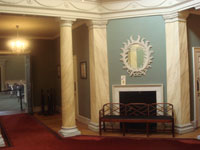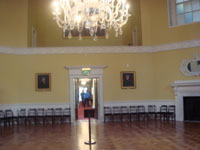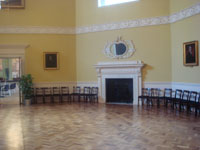|
I. "Thinking with"
A. Allying with the ironic narrator
(in assessing characters, in understanding the necessity to 'hit the mean,"
etc.)
B. Responding to (cooperating with) generic conventions
1.
Expecting a reversal of power and a restored order NB: When Lady Elliot
was alive all was in good order.
2.
Recognizing that what looks like an impediment will actually turn out to
be a step toward felicity (Wentworth & Louisa Musgrove)(NB: Anne's own
statement that Mr. Elliiot has become a positive evil because he impedes her
connection with Wentworth.
C. Understanding
that Bath is a site for Austen's critique of social rank but also a site
for unexpected conjunctions.
From Left to Right: The Assembly Rooms--Interior,
Exterior, Interior -- Photos by Elizabeth Losh
D. Assessing the Navy: a meritocracy vs. an "ancient and respectable family"
(46).
E. Defending the Navy
►Wars in the background:
● The American war 1775
● Napoleon
● The American war
1814
Three
views of the Octagon Room in Bath. See Persuasion, Part II,
Ch. 8.
F. Persuasion,
with Amanda Root, Ciarán
Hinds
► Opening scenes: Look for the
parallel & opposition between the "ancient" family
and the Navy.
►This film is thinking with Austen.
II. "Thinking
against"
A. Life on a ship - some details (See
"Supporting quotations for Lecture #3
on Austen.")
B. "Jane
Austen and Empire" - the Said thesis in Culture and Imperialism (See "Supporting quotations for Lecture #3
on Austen.")
III. "Thinking
with" and "Thinking against":
●An example
►"On quitting the Cobb, they all went
indoors with their new friends . . . gratification" (127-8).
►"Captain Harville was no reader; but
he had contrived excellent accommodations, and fashioned very pretty shelves
. . . " (128).
|








